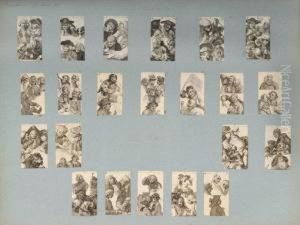Ernst Ludwig Riepenhausen Paintings
Ernst Ludwig Riepenhausen was a German engraver and artist born in 1765 in Göttingen, Germany. He was part of the Riepenhausen family, which included several artists, and he was the son of Johann Georg Riepenhausen, who was also an engraver. Ernst Ludwig's work was shaped by the artistic movements of his time, particularly by the influence of Neoclassicism, which was prominent in European art during the late 18th and early 19th centuries.
Riepenhausen initially trained under his father, and later, he furthered his studies by traveling to Italy, which was a common practice for artists at the time to refine their technique and to study the masterpieces of the Renaissance and classical antiquity. His time in Italy was influential in his development as an artist, as it exposed him to the works of great Italian masters and the classical ideal of beauty.
During his career, Riepenhausen was known for his fine line engravings and etchings. He produced works that were often reproductions of paintings by other artists, as well as original compositions. His engravings covered a variety of subjects, including historical scenes, portraits, and interpretations of literary works. One of Riepenhausen's significant contributions to the art world was his role in disseminating the works of other artists through his engravings, which allowed a wider public to access and appreciate art that they might not have had the opportunity to see in person.
Riepenhausen's legacy extends to his influence on other artists and his contribution to the printmaking field. His engravings were not only important for their aesthetic quality but also for their role in art history as a means of preserving and sharing the visual culture of his era. Ernst Ludwig Riepenhausen passed away in 1840, leaving behind a body of work that continues to be of interest to art historians and collectors. His works are held in various collections and are studied for their technical skill and historical significance.
